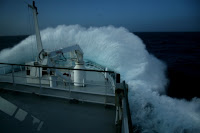49N, 35W. Wind 35kn, Air 11C, water 11C.
 |
| Force 9 |
After a sleepless night for many (except Emily who slept soundly!) given the high swell (
average of 9m) and winds (gusts of 76knot, F12), a respite in the weather was a welcome sight this afternoon. The sea state improved although the swell stayed high. Myself, Emily and Alessandro carried out visual surveys for cetaceans and birds from the bridge. There was a pod of 12 pilot whales (including 2 calves) seen about 200m from the ship this morning, followed by many kittiwakes, a juvenile lesser-black backed gull and a juvenile glaucous gull. The glaucous gull provided some entertainment as it chose to land on the most exposed part of the deck...
A few puffins were also seen, donning their winter plumage, as if they'd been in a coal bunker: a sooty face and a dull beak, no comparison to their bold summer colours. Fulmars were more abundant today by comparison with previous days.
The temperature is fluctuating a lot going from 2C to 13C in only 3 hours with a snow shower this morning - a little taste of things to come I reckon. We are still in the influence of the North Atlantic Drift, but it will be interesting to see if the fauna changes as we enter the cold Labrador Current in the coming days. Now I'm off to bed to cling on to the mattress for a few hours.
 |
| View from the bridge looking ahead! |


















